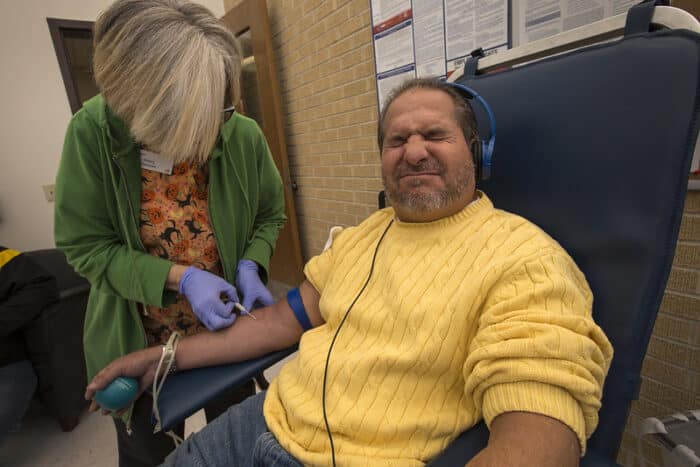If you have ever entered a hospital or a clinic for blood work, you might have been greeted by the friendly face of a phlebotomist.
Phlebotomists are allied healthcare professionals who are trained to perform blood draws. But have you ever wondered if these professionals can also start IVs (intravenous lines)?
In this article, we’ll discuss just that. We will uncover if phlebotomists can start IVs, which states allow them to do so, which do not, and what you can do if you don’t want to begin IVs as a phlebotomist.
So, let’s start digging in.
Read: What is a Phlebotomist
State-by-state Breakdown of Where Phlebotomists Can Start IVs
The question of whether phlebotomists can start IVs is a great dilemma among aspiring phlebotomists.
Let us break it down for you, according to each state.
Generally, IVs are out of the scope of a phlebotomist’s practice, since most states require a proper license for healthcare professionals to start IVs.
However, some states allow phlebotomists to start IVs with specific training and certification, such as California, Pennsylvania, Illinois, and more.
More on such states in the next section.
More on: Phlebotomy Certification
States That Allow Phlebotomists to Start IVs With Training
As mentioned earlier, some states allow phlebotomists to start IVs, given they have had special training.
It is important to note, however, that these regulations for each state are subject to changes.
Here is a state-by-state breakdown of some states that allow phlebotomists to start IVs:
- California: Phlebotomists in California are generally not permitted to start IVs unless they have completed additional training and certification apart from the standard phlebotomy training.
- Texas: Phlebotomists in Texas may be permitted to start IVs, but this usually requires additional specialized training and certification.
- New York: Phlebotomists in New York may also be allowed to start IVs only if they have undergone specific training and have been granted the necessary certification.
- Florida: Phlebotomists in Florida typically cannot start IVs without additional training and certification.
- Ohio: Similar to other states, phlebotomists in Ohio may require additional training and certification to be allowed to start IVs.
- Georgia: Phlebotomists in Georgia may also require additional credentials to perform IV insertions.
- Washington: Phlebotomists in Washington State might need further training and certification to perform IV insertions.
- Illinois: Phlebotomists in Illinois may not be authorized to start IVs under their standard scope of practice.
- Pennsylvania: The scope of practice for phlebotomists in Pennsylvania might not include starting IVs without specialized training and certification.
- Michigan: As of 2021, phlebotomists in Michigan might not have the authority to start IVs without specialized training.
- North Carolina: Phlebotomists in North Carolina may not be authorized to initiate IVs without additional certification.
States That Do Not Allow Phlebotomists To Start IVs
Most of the states, as we discussed earlier, do not allow phlebotomists to start IVs, simply because it is out of their scope of practice.
Phlebotomists usually can’t start IVs in most states because starting IVs is a bit different from drawing blood.
IVs are like tiny tubes that go into your veins to give you medicine or fluids. Since they are intravenous, inserting them in needs special skills, like knowing where to position the IV, how to prevent any injuries or issues, and what to do if something goes wrong.
Because this is trickier and riskier, states often only allow phlebotomists to start IVs with extra training and a special certificate. This way, patients stay safe, and the right people do the job with the right skills.
Also read: Phlebotomist Skills

Do You Want To Become a Phlebotomist? Check Out Free Phlebotomist Masterclass!
In our masterclass you learn:
- How to be a Phlebotomist faster…in just 2 months!
- Avoid student debt & driving to classes
- #1 thing employers want from Phlebotomists
- How to stand-apart & get a university certificate for a strong resume
How To Become a Trained Phlebotomist
If you’ve decided that becoming a phlebotomist and making a difference in people’s lives is what you want to pursue, you might be wondering about the steps to turn that dream into reality.
We’re here to guide you through the entire process.
Here are four simple steps you need to follow to become a phlebotomist:
1. Finish your high school diploma or GED:
The very first thing you need to do is complete your high school diploma or get a GED. This is the basic requirement to kick-start your journey to becoming a phlebotomist.
2. Enroll in a phlebotomy training program:
The next step is to pick a recognized phlebotomy training program that suits your preferences. You have two main options for completing your training: you can go for a certificate/diploma program offered by a community college or vocational school, or you can opt for an online course.
Choosing an online program is often recommended because of several advantages, such as:
– Flexibility: You can learn from anywhere, even from the comfort of your own room.
– Self-paced learning: Some online programs allow you to study at your own pace and convenience.
– Affordable: Online courses can be completed for under $2,000, helping you avoid unnecessary student loans.
– Faster completion: You can finish the course in as little as 2 to 4 months, which means you can enter the workforce sooner.
Also see: How Long is a Phlebotomy Course?
Check out PREPPY’S ONLINE PHLEBOTOMY TRAINING PROGRAM here>
3. Gain hands-on experience:
Once you complete your training, it’s time to gain practical experience through externships or internships.
Some online programs offer these opportunities after course completion, making them a smart choice.
4. Obtain certification:
While certification might not be mandatory in all states, employers highly value it.
This step is often questioned by aspiring phlebotomists, but in a nutshell, being certified can give you an edge. Among the many certifications available, the three most recognized are:
– Phlebotomy Technician (PBT) certification from the American Society for Clinical Pathology (ASCP).
– Certified Phlebotomy Technician (CPT) certification from the National Healthcareer Association (NHA).
– Registered Phlebotomy Technician (RPT) certification from the American Medical Technologists (AMT).
5. Apply for phlebotomy jobs:
Once you’re certified as a phlebotomist, you’re ready to start applying for the positions you’re interested in.
Also see: How to Become a Phlebotomist
Conclusion
In conclusion, while a phlebotomist’s primary role is to draw blood, there are circumstances where they may be trained to start IVs. However, this practice varies by state and institution, and additional training and certification may be required.
Phlebotomists play a crucial role in patient care, but when it comes to starting IVs, it’s essential to prioritize safety and ensure that only qualified and trained individuals perform this procedure to guarantee the best possible patient outcomes.
Related Resources:
- Day in the Life of a Phlebotomist
- Ultimate Phlebotomist Resume Guide – Phlebotomy Job
- Phlebotomist Duties
- What is the Difference Between a Licensed Phlebotomist and Certified Phlebotomist?
- Where Can a Phlebotomist Work?
- Phlebotomy Externship
- Phlebotomist Degree
- Mobile Phlebotomist
- How Long Does it Take to Get a Phlebotomy Certification?
- What are the Different Types of Phlebotomy Certifications?
- Phlebotomist Cover Letter
- Phlebotomist Lab Technician
- Therapeutic Phlebotomy
- Certified Phlebotomy Technician
- Cardio-Phlebotomy Technician
- Online Phlebotomy Classes
- Order of Draw Phlebotomy
- Phlebotomy Internship
- Phlebotomy Interview Questions
- 4-Week Phlebotomy Classes Online
Related Articles
-
How to Be Successful in College in 2022 – 7 Simple Tips to Succeed
-
How Do Scholarships Work? Read This First…Truth is Shocking
-
7 Best College Majors 2024: What Should I Major In?
-
How to Choose a College – 10 Things You Must Consider in 2024
-
Why Go to College? Top 13 Benefits for Adult Students in 2022
-
Top 5 Best Alternatives to Community College for 2024







